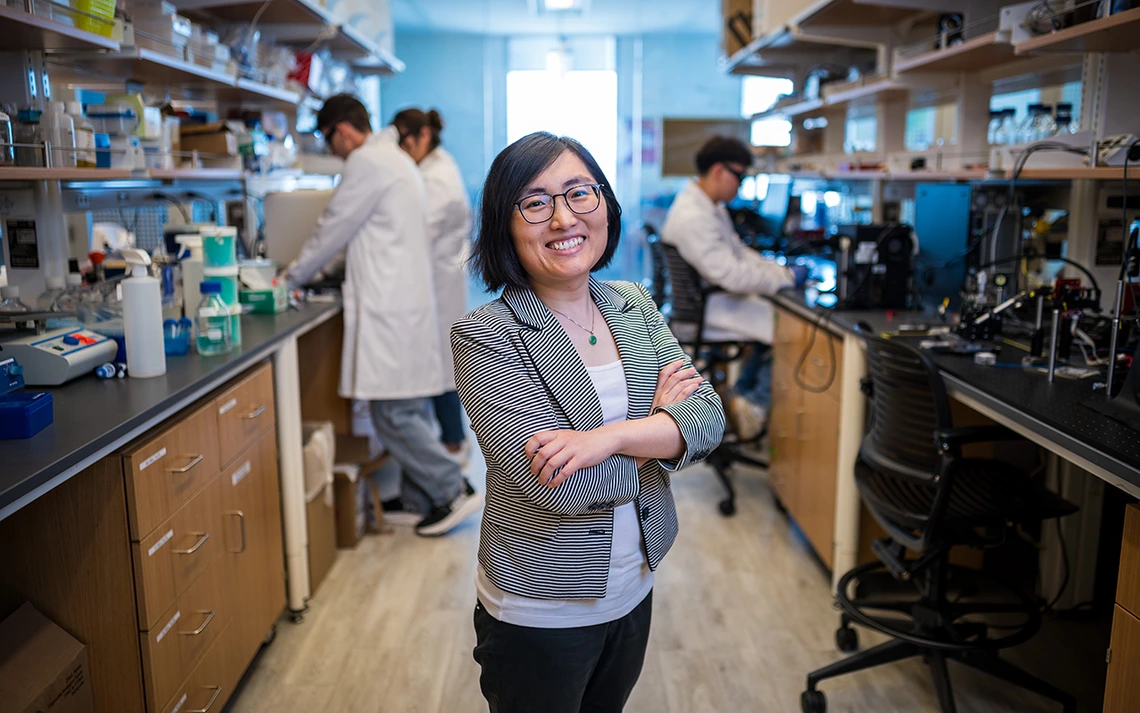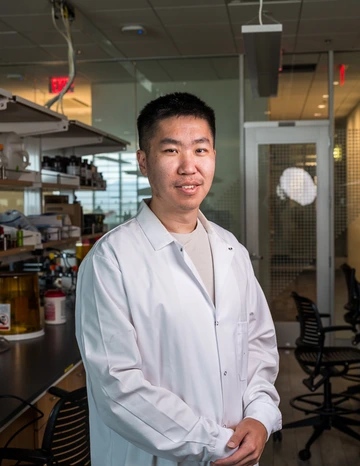NIH grants Shang Song $2.32M for spinal cord bioimplant
Award recognizes the biomedical engineer’s work toward treating spinal injuries and diseases.

The University of Arizona’s Shang Song, Frank L. and Daphna Lederman Professor and assistant professor of biomedical engineering, supervises students in The Song Lab investigating health care devices that speed injury recovery.
The National Institutes of Health granted Shang Song a five-year Director's New Innovator Award of $2.32 million to develop a bioimplant that treats spinal cord injuries and their associated complications.
Song, Frank L. and Daphna Lederman Professor and assistant professor of biomedical engineering, is creating a closed-loop neuromodulation implant device expected to reduce pain from spinal cord injuries, improve motor recovery and promote spinal plasticity.
The device leverages neuroplasticity — the ability of nerve cells to reconnect and form pathways to perform body functions — to treat spinal column damage.
The Director’s New Innovator Award is part of NIH’s prestigious High-Risk, High-Reward Research program, which supports scientists' unconventional approaches to major challenges in biomedical and behavioral research.
“The department is proud to see one of its youngest faculty win this prestigious NIH award,” said Mario Romero-Ortega, head of the Department of Biomedical Engineering in the College of Engineering. “Dr. Song is a rising star in the biomedical field, and her innovative work in regenerative medicine and organ-on-chip systems will contribute to uncovering new therapeutic options in these key areas.”
Song, also a member of the BIO5 Institute, received support from the College of Engineering and BIO5 Institute, as well as $200,000 from the Eighteenth Mile Funding Program – a grant under U of A’s Technology and Research Initiative Fund – to collect preliminary data for the award.
The first of its kind
According to the American Association of Neurological Surgeons, more than 17,000 Americans annually suffer spinal cord injuries, which can lead to acute chronic pain and loss of motor function.
“Other neurological functions of the body, like heartbeat, breathing and bowel function, can also be affected,” said Song. “Even in less severe cases, quality of life can be drastically lowered.”
Presently, no treatment exists to repair spinal cord damage, according to the Mayo Clinic.
Song's implant uses electrical stimulation to promote neural learning and plasticity, forge neural connections, and retrain the nervous system.
"Traditionally, the spinal cord has been viewed as a hard-wired and passive conduit, merely relaying signals," she said. "However, this view is incomplete. The spinal cord has a remarkable ability to adapt and that gives us the key to restoring its function."
The device encourages the spinal cord to find neural pathways that reduce pain while promoting motor recovery. With repeated stimulation, the spinal cord learns which signals improve movement and decrease discomfort.

Biomedical engineering doctoral student Lin Li works on novel technology for Shang Song, the NIH Director’s New Innovator Award recipient.
It also incorporates biodegradable, FDA-approved materials that break down in the body naturally, with material components adjusted depending on the required treatment period. This design eliminates the need for removal surgery and reduces the risk of long-term complications.
Bridging technology, medicine
Lin Li, a biomedical engineering doctoral student in The Song Lab, is helping design and develop the platform that sends electrical signals to the spinal cord.
“What excites me most is that this research directly bridges technology and medicine. I’m learning how to integrate engineering tools like microfabrication, signal processing, and materials science with neuroscience applications,” said Li.
“It’s rewarding to know that advances in our system could improve patient quality of life after spinal cord injury.”



